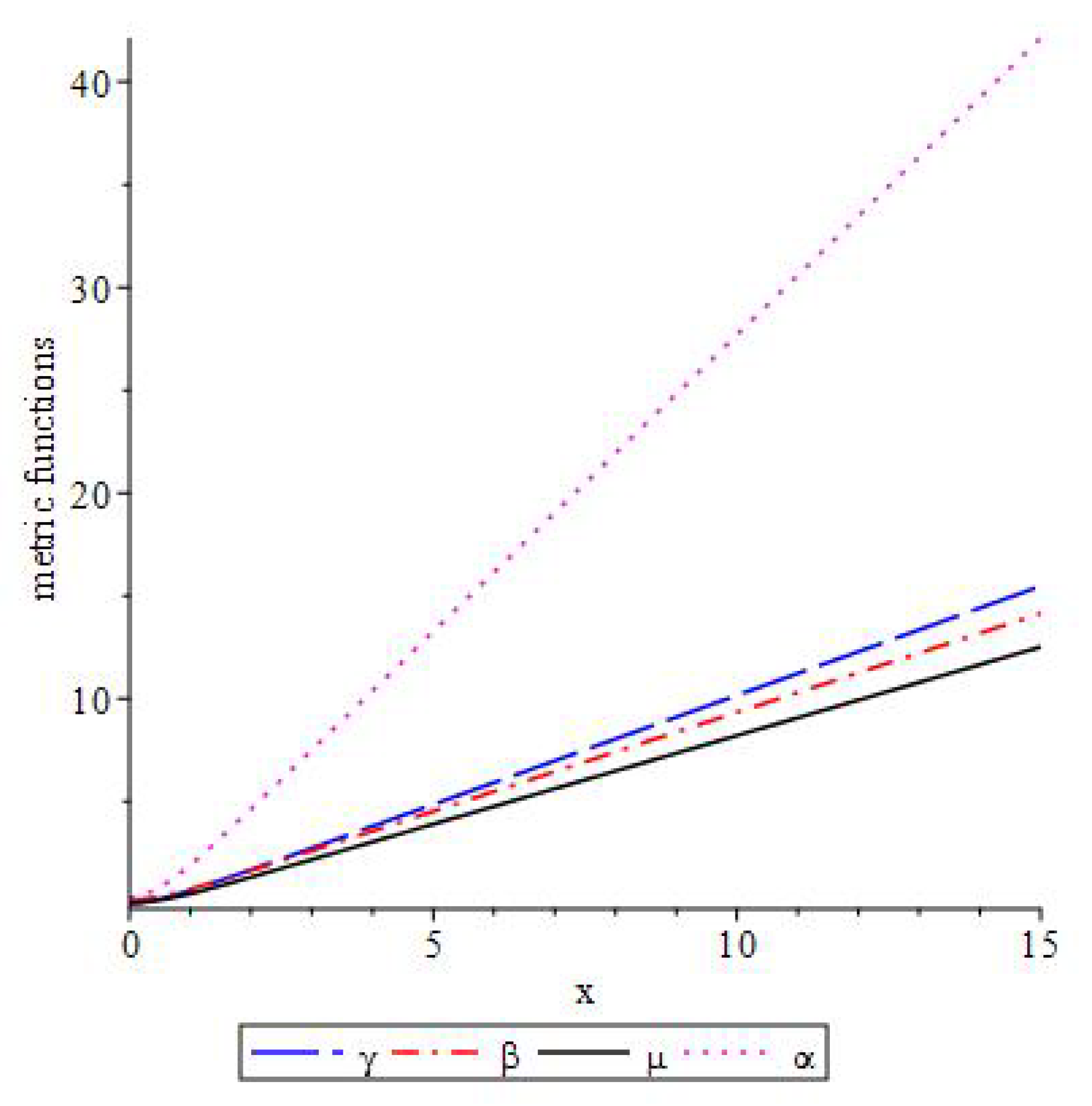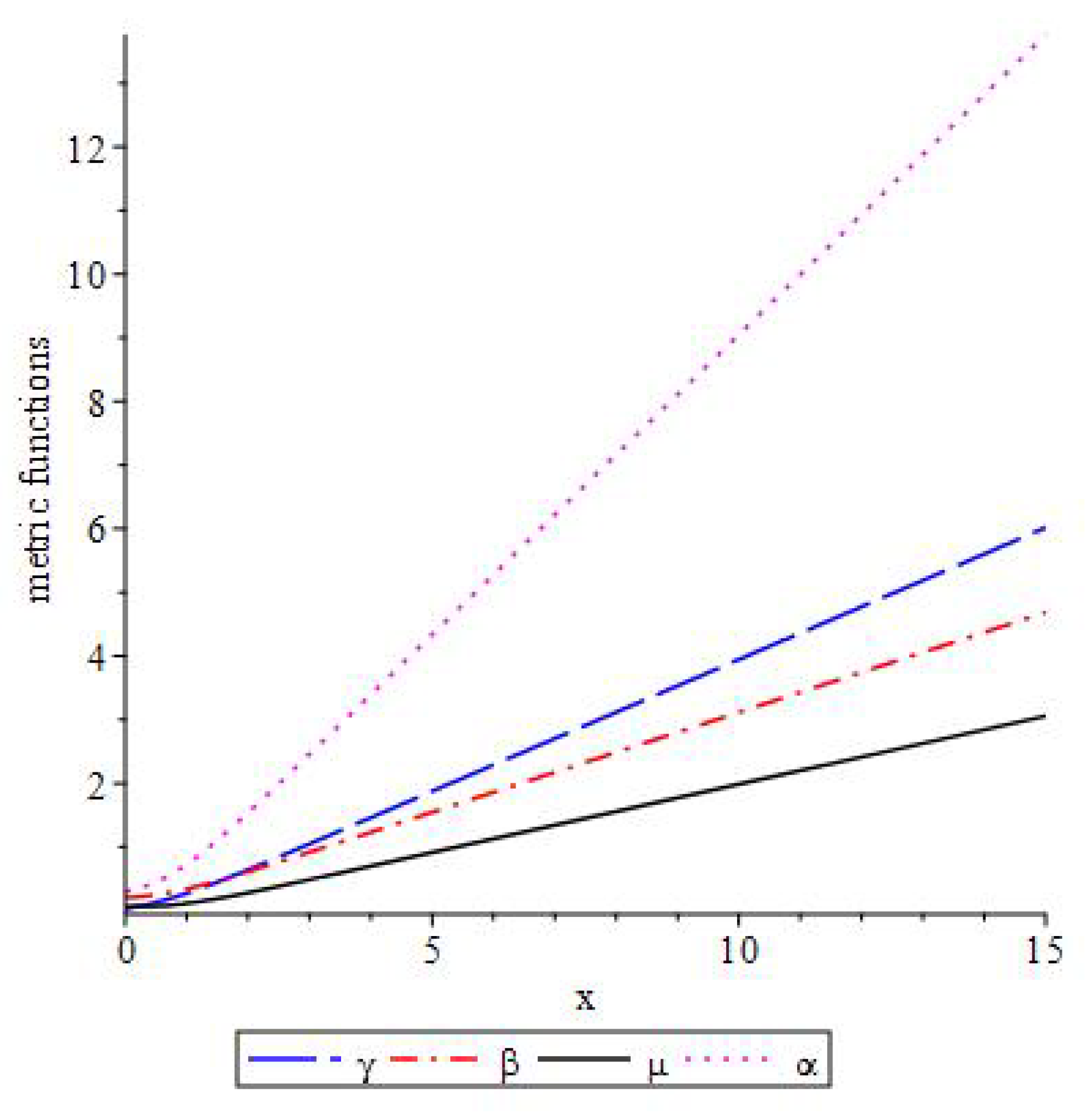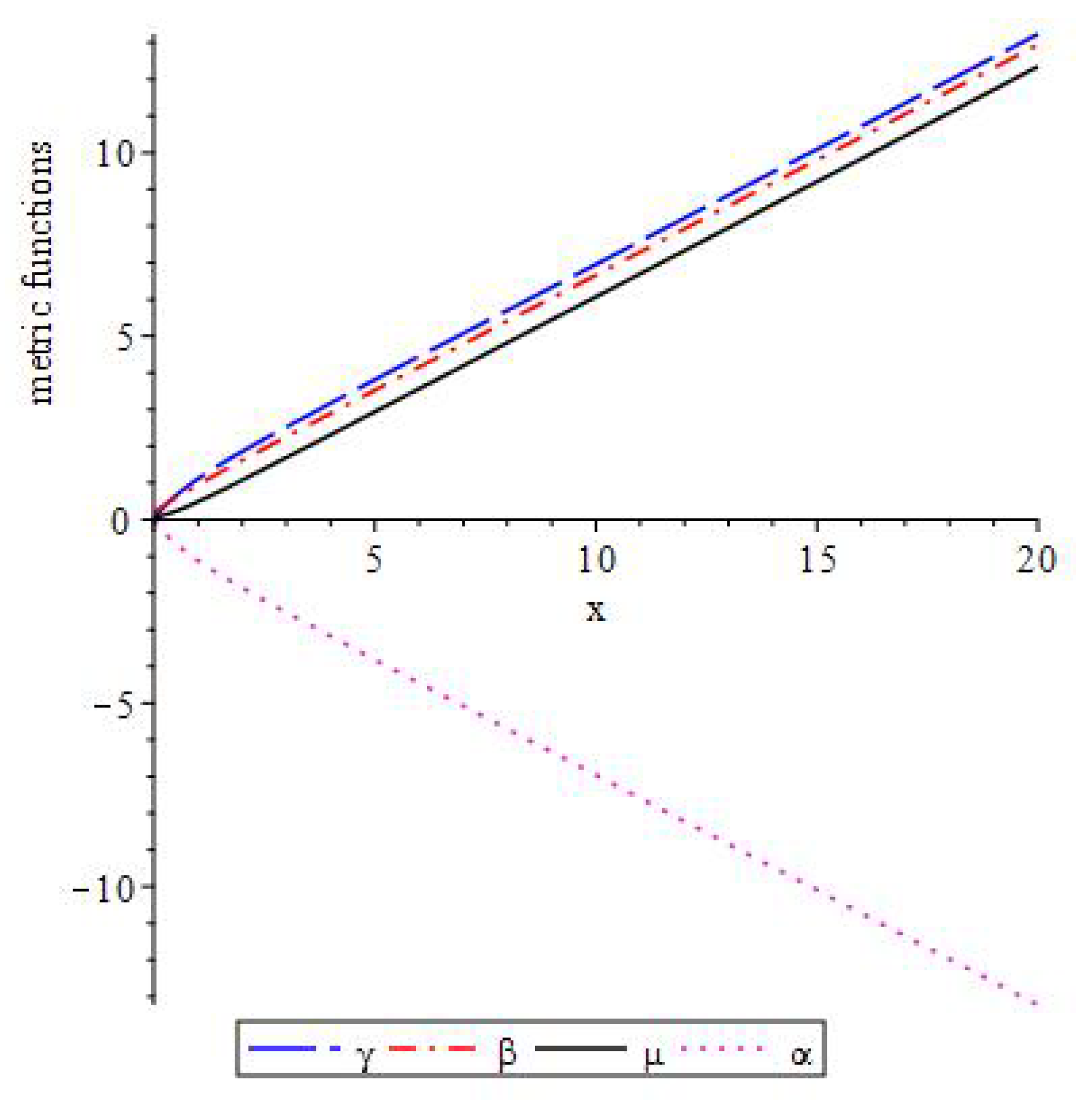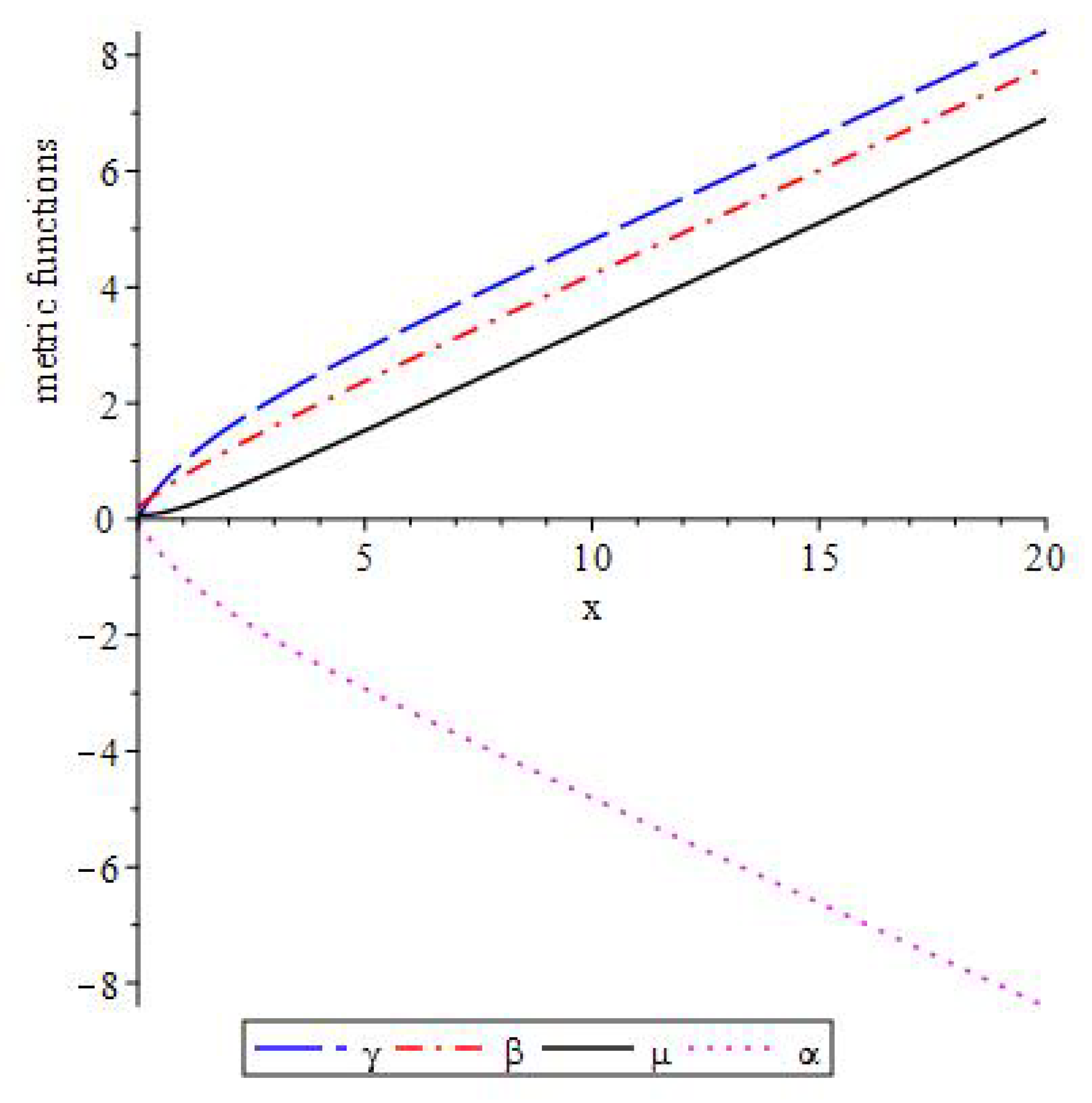1. Introduction
In recent years spinor field has been used in cosmology by many authors [
1,
2,
3,
4,
5,
6]. The ability of spinor field to simulate different kinds of source fields such as perfect fluid, dark energy etc. [
7,
8] allows one to study the evolution of the Universe at different stages and consider the spinor field as an alternative model of dark energy.
To our knowledge, except for the Friedmann–Robertson–Walker (FRW) model given in Cartesian coordinates, in all other space–times spinor field possesses nontrivial non-diagonal components of the energy-momentum tensor. This very fact imposes severe restrictions on the geometry of space–time and/or on the components of the spinor field [
9]. As far as static spherically symmetric space–time is concerned, the presence of non-diagonal components of EMT imposes restrictions on the spinor field only [
10].
Introduction of the spinor field in a classical theory such as general relativity and cosmology gives rise to several questions due to its quantum origin. Many specialists think that even if one uses the spinor field in general relativity, he should treat it as Grassmann variables. This is partially right, though we think that spinors can be treated as classical complex projective coordinates in the spirit of Dirac-Sommerfeld-Brioski [
11,
12,
13] as well. In this approach they describe the condensation of “quark-antiquarks” and are ordinary classical fields [
14].
Note that spinor fields were introduced into the Einstein system exploiting both quantum and classical interpretations. A Fermi field coupled to a homogeneous and isotropic gravitational field was considered in [
15], while the spinor was treated as a Grassmann variable in [
16]. Dolan has studied the Chiral Fermions and the torsion arising from it within the scope of FRW geometries in the early Universe [
17]. In doing so he argued that a quantum matter can be used as a source for the classical field while the quantum aspects of the field itself can be ignored.
As it was mentioned earlier, recently spinor field is being used in astrophysics. Most of these works were done within the scope of static spherically symmetric space–time [
10,
14,
18]. Since a number of astrophysical objects are given by cylindrically symmetric space–time [
19] in this report we plan to consider the spinor field within this model. String-like configurations of nonlinear spinor field in a static cylindrically symmetric space–time was obtained in [
20]. An interacting system of nonlinear spinor and scalar fields in a static cylindrically symmetric space–time filled with barotropic gas was considered in [
21]. Unfortunately, the authors did not take into account influence of the spinor field that occurs due to the presence of non-diagonal components of EMT. In this paper I plan to address those problems overlooked there and see if spinor field can be exploited to construct different types of configurations seen in astrophysics.
2. Basic Equations
The action we choose in the form
where
is Einstein’s gravitational constant,
R is the scalar curvature and
is the spinor field Lagrangian given by [
2]
To maintain the Lorentz invariance of the spinor field equations the self-interaction (nonlinear term)
is constructed as some arbitrary functions of invariants generated from the real bilinear forms. On account of Fierz equality in (
2) we set
Setting
for
K we obtain one of the following expressions
. Here
and
are the invariants of bilinear spinor forms with
and
being the scalar and pseudo-scalar, respectively. In (
2)
is the self-coupling constant.
The covariant derivatives of spinor field takes the form [
2]
where
is the spinor affine connection which can be defined as [
2]
Here
and
is the Christoffel symbol. In (
4) the Dirac matrices in curve space–time
are connected to the flat space–time Dirac matrices
in the following way
where
and
are the tetrad vectors such that
The
matrices obey the following anti-commutation rules
Let us consider the cylindrically symmetric space–time given by
where
and
are the functions of the radial coordinate
u only.
The tetrad we will choose in the form
From
we find
with
The nontrivial Christoffel symbols corresponding to the metric (
5) are
Then from the definition (
4) we find the following spinor affine connections
:
The spinor field equations corresponding to the spinor field Lagrangian (
2) are [
2]
where we denote
On account of (7) from (
2) one finds that
Let the spinor field be a function of
u only, then in view of (
6) the spinor field equations can be written as
where prime denotes differentiation with respect to
u. In (8) we also define
The energy-momentum tensor of the spinor field is defined as [
2,
22,
23]
From (
10) one finds the non-trivial components of the energy-momentum tensor of the the spinor field
with
being the pseudovector. It can be noticed that
and
might be positive or negative under certain conditions.
From (8) we find the following system of equations for the bilinear spinor forms:
Equation (12) yields the following relation
In case of
, i.e.,
from (
12a) we find
If
, then in case of a massless spinor field from (
12b) we find
Let us consider the case when
. In this case
. Then on account of expression for
and
from (12a,b) for the massless spinor field we find
which yields
Finally in case when
, i.e.,
from (12a,b) for the massless spinor field we obtain
which leads to
The Einstein tensor corresponding to the metric (
5) possesses only diagonal components. So let us first consider the diagonal equations of Einstein system
Subtraction of (
20d) from (
20b) yields
with the solution
Analogically, subtracting (
20d) from (
20c) one finds
In view of (
9), (
22) and (
23) one finds
Thus,
,
and
can be found in terms of
and
. Let us find the equation for
. Summation of (20b–d) and 3 times (
20a) gives
Recall that for non-diagonal components of the EMT of the spinor field we have non-trivial expressions, whereas the non-diagonal components of the Einstein tensor in this case are trivial. Equating these expressions to zero from (11c–e) we obtain the following constrains
The foregoing expressions give rise to three possibilities:
It should be noted that in a Bianchi type-I space–time there occur similar possibilities [
16]. In that case under the assumption (
27a) the spinor field becomes massless and linear [
16]. In a static cylindrically symmetric space–time that is not necessarily the case.
Unfortunately, right now we cannot exactly solve the equation for defining either or . So we have to assume some coordinate conditions. There might be a few. In what follows, we consider the case with , as in this case it is possible to consider massive spinor. Further we set and
Case 1: Let us first consider the harmonic radial coordinate
u such that the following relation holds for the metric functions [
24]:
In view of (
9) Equation (
25) takes the form
Let us consider the case when
F is a power law function of
K, i.e.,
. Inserting
and
into (
25) on account of
we find
with the first integral
So the solution can be given in quadrature
Let us consider some simple cases those allow exact solution.
Fisrt we study the Heisenberg–Ivanenko type nonlinearity when
. It can be obtained by setting
in (
31). In this case (
31) takes the form
which finally gives
For a general power law type nonlinearity we study the massless spinor field. Setting
in (
31) we have
with the solution
For a more general solution to the Einstein equations with massive and nonlinear spinor field as source we rewrite it in the form of Cauchy:
This system can be solved numerically. In
Figure 1 and
Figure 2, we have plotted the metric functions
for different types of nonlinearities, namely,
(Heisenberg–Ivanenko case) and
. For simplisity, we set the following values for other parameters
,
and
. The initial values were taken to be
,
,
,
and
. As we see from the graphics, with the increase of the value of
n the difference between the metric functions increases.
Case 2: Let us consider the quasiblogal coordinate
[
25]. In this case for
we have
whereas inserting (
22) and (
23) into (
20a) for
we find
Let us rewrite (
38) and (
39) in the Cauchy form
where
As one sees, the above-going system is valid if and only if
. The Equation (
40c) is found from (
39), which is a quadratic equation with respect to
.
In the
Figure 3 and
Figure 4, we have plotted the metric functions for the same values as in previous cases, i.e., we set
,
and
and the initial values were taken to be
,
,
,
and
. Here we have consider the cases with
and
. Moreover, like the previous cases we see with the increase of
n the difference between the metric functions increases.








